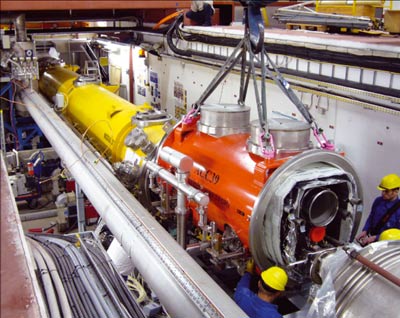
Image credit: Kay Jensch/DESY.
On 2 September, user operation resumed at the FLASH free-electron laser (FEL) at DESY in Hamburg after a major upgrade that boosted its energy to 1.2 GeV and its wavelength to 4.45 nm. The third user run will last a year and comprise more than 350 twelve-hour shifts. It is already overbooked by a factor of three.
FLASH, the world’s first soft X-ray FEL, has been available to photon-science users for experiments since 2005. Last winter, the facility underwent an extensive five-month upgrade. The photo-injector was replaced with a new electron source that generates considerably less dark current and features a low transverse emittance. A further superconducting accelerator module – a prototype for the European XFEL hard X-ray laser – was added to the six that are already installed, increasing the beam energy from 1 to 1.2 GeV. This enabled the FLASH team to set a new record for the facility, pushing the wavelength from 6.5 nm to 4.45 nm in June.
Another key element is a new module with four superconducting cavities operating at 3.9 GHz rather than the 1.3 GHz customary at FLASH. This third-harmonic RF system – built at Fermilab in collaboration with DESY – flattens the energy distribution of the electrons in the bunch, leading to a linearization of the longitudinal phase space. The system is now routinely in operation, allowing a considerable increase in the energy of a single photon pulse to a couple of hundred microjoules and more flexibility in adjusting the duration of the photon pulse. This also constitutes an important test for the European XFEL, which is to be equipped with similar modules.
In addition, the FLASH team installed a seeding experiment (sFLASH) in which light amplification will be triggered using an optical laser – as opposed to the current self-amplified spontaneous emission (SASE) process in which amplification is started by the stochastic radiation that the electron bunches emit along the undulator. The optical laser provides the seed radiation with a wavelength of 38 nm by generating higher harmonics of the optical wavelength in a gas cell. The seeding will make it possible to reduce significantly the intensity fluctuations between individual pulses and enhance further the laser properties of the radiation. The radiation produced this way will be made available at a separate beamline, without interfering with the rest of the FLASH operations.
FLASH thus continues to offer new and unique experimental possibilities. The shortest wavelengths may even allow for first experiments on carbon in organic molecules, while magneto-dynamics experiments, with the third-harmonic wavelength, will benefit from the substantially increased intensities.





